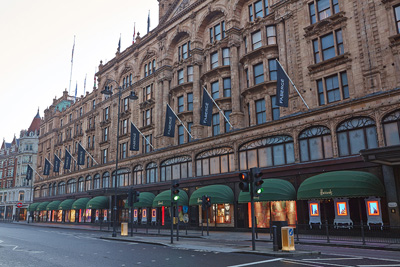While the United Kingdom is currently the third-largest luxury goods retail market in Europe, it is on pace to become number one in 2018, according to a new report by Conlumino.
While currently only holding 15.8 percent of the total luxury retail sales in Europe, or $17.6 billion, the UK is projected to grow to encompass 19.6 percent of the total by 2018. The UK is successfully attracting luxury shoppers, which may help it outpace the current top two, Italy and France.
"[The UK is] attractive to tourists of all ages, including the new younger luxury shoppers, because of its high profile as a tourist destination, particularly London, and the wide range of shopping opportunities it has, which have expanded over the past couple of years,” said Maureen Hinton, group research director at Conlumino, London.
"[It is a] good place to live and work for the global rich because it has a lot to offer in terms of a stable and growing economy, cultural and social destinations, newly introduced faster access to visas to visit and work here," she said.
Conlumino's report covers clothing, jewelry and watches, beverages, personal care, home furnishings, luggage and leather goods, consumer electronics and more.
Moving on up
Italy and France and currently ranked first and second in European luxury retail, based on percentage of market share. They are each expected to drop down one spot to second and third in 2018, to make room for the UK, due to poorly performing economies and reduced spending of their citizens.

Cartier at Selfridges
Germany, Russia and Spain, which currently sit at four, five and six respectively, are projected to remain in their positions.
Norway will likely lose its spot in the top 10, making way for Poland to take its place as ninth.
The UK is gaining favor largely due to its tourism. The country has relaxed tourist visa restrictions and increased expenditure from tourists, especially those from Russia and China. Wealthy individuals from Greece and Russia also invest in property in the UK due to its comparative stability.
Yearly events, such as Wimbledon, Ascot and Henley, spur tourist visits, while its cooler climes attract Middle Eastern tourists in the summer months.
Department stores, including Harrods and Selfridges, continue to make London attractive for luxury shoppers.

Harrods
To capitalize on the growing retail in the UK, brands should work on maintaining, or growing, their presence.
"[Brands should] make sure they have a presence here in the right locations and with the right partners, and engage with appropriate media in the UK in order to maintain a high profile, sponsoring events such as Cartier Polo which is well established, but other cultural events as well," Ms. Hinton said.
Europeans spent the most on clothing over any other type of luxury good, with $27 billion spent total. Jewelry, watches and accessories came second, with total spend of $19.8 billion.
Luxury goods sales in Europe are expected to reach $149.8 billion by 2018.
The report also found that luxury conglomerate LVMH Moët Hennessy Louis Vuitton holds the highest share of luxury goods retail in Europe, with 13.9 percent. Following are the groups Richemont and Kering, at 6.2 and 3.8 percent respectively.
Rounding out the top 10 are L’Oreal Luxe, Hermès, Prada, Swatch Group, Ralph Lauren, Giorgio Armani and Burberry.

Hermès Metamorphosis campaign
Spending spree
Other projections of the years ahead show positive signs for luxury.
Luxury consumption will grow organically over the next 10 years with overall spending growing from approximately $985.5 billion today to almost $1.2 trillion in 2020, according to a new report.
Consumers will be the main driving force of this growth, with the number of luxury consumers rising from 380 million today to 440 million by 2020. This presents an opportunity for luxury brands if they know how to market to core luxury consumers as well as new consumers, since they require diversified strategies (see story).
Digital innovation was a top priority for British luxury brands in 2013, with mobile commerce becoming an increasingly important focus, according to a new report from Walpole British Luxury and Ledbury Research.
The 2013 UK Luxury Benchmark study found that despite uncertain economic times in Europe, 83 percent of brands expect to see a rise in sales this year and the British luxury sector is on track to grow 12 percent this year as well. British luxury marketers are looking to keep their brands fresh by focusing on innovation, but a significant challenge will be joining their traditional values with the desires of the younger generations (see story).
This investment will likely pay off as the luxury consumer gets younger.
"Apart from a change at the top in country order, luxury retailing is moving beyond the typical clothing, jewelry categories into luxury technology such as wearables and new younger designers are entering the market and appealing to a new generation of shoppers, the millennials, whose primary method of engagement is digital," Ms. Hinton said.
Final Take
Sarah Jones, editorial assistant on Luxury Daily, New York
{"ct":"tfuz4uXwhamqdm9sQYDOq+0hsOudg\/40FPQVrsHcAKRujs9lm0VTG08rXIJG+wQR6oGgFMWmDWfmc9dpw7hPIrH2hN\/hT3x6xQBMslMQtj6iwB+Kv\/GAtE6o462PEsqvQto5CZJqGvpoFHcPGO6JainSLIdPUMKIaQKDfIarykG4OGW9fUWp2e\/k75DDQdn5Av37N99ESbJ6wmhwF4dv9qR9G5mjewgTXgp7WrJDpD29OFI6PEGzjTMO64as89iTlwSq\/7E6HiOvZRWPbLpmJHZ+w0ubk69vfUZi\/Wc34gJ4MJktOVmCO\/uv\/MeHVJzBpLAaSS69b7z8ntkRFNzuSdi3PHaJfviyQg1mLipS5Bsj\/ScRgmTv7+3\/vJ16VlQUUUT952SjwLDd1rTb+wA13k8ARXnKWde8NeFUIBIEfXHwbMv7kR8wgrm7IGArseqza7wYXQXYXBZ1k7lCSSQK1c8tBZubeY54pTi1gnQlylD\/LqSn59ewO76DJJ7CGwmUrDXP4RbaCwV4hTAHD8GBvrr0EpTJLYqIiKkXUibYGdGCuYTS4kzbfKV8jAj6SbADCdhVDcZSZKh46PP8G9s45\/f6ESnQgr7GQCoQ+PokhdkArRZc\/uF6uj3tazzn5SIH7UIQrg\/WIHGB\/7S8VgA+81R\/Fxlgq5zU7iMuw4hjoiz4a3CDija2C41s\/B7ZRcLxV2a5WQHxBh9stJJVnDeZ5Adrrbgb66UZeQItzCNc+DB+YMyEAEEUkb7l8yn3CYYrALCzNTP04VWnO3OkRCNwjpRwohOCVQ76Jk\/XX7e0YWJXgTvDbZ+7fH8UgX6LU+ruroDP6YfIy+BckhZAhoiKze7Hrsfa1z21bukLBnB\/2QcUP8l2z30DxD53\/L7DlBJqQuMGasAa2ZV83ut4j4DjpKvVlq\/LiU10cdV015HEfxtrNBcx1SiI5ebmLfPpOxhxbvk05UPcUMTz2g\/UAn5qLVrbUvzeUnaLB+orbxExskbsHVibiZEorkYOvpP\/0DkFGRmkBb8Drq6ANYV+ym+X2CzINVp1SmF7djbNmbj2lq4MULzpzQRVzyM\/nIj6Ls\/mTdD3sRWcV5oS9S0OTGyHHlU\/nf1LTYlKl50WFw3qsxu1Vc\/t30IS1ahuB4zEXf9+raJXF5wH6X4KV3EF1HJIcLNca7jSMdgz3FjY2oQ+XMuUOajVSMBu+PjNqQXZbYmT7JIheDENNYz0ruKMIrw9EDipXhFzcoRax4EbEfyJLcA7iGbeVVOdfq01sZtF1XXOVHI59frWNy9+xdEcKl\/piGc8bKuuNv6cHiEYgm7C4a\/ZIEgHSnHZDf7qPkSupHYVWjWABDEaDTPxFtnwtSQe9nFoJf5XmXIQoWY13Nce0tQcywiTXTOJvdTJQBABQTVs0ul\/D1Co3lYHuvrBT1xiYNEe+UKFnad57iCEb1\/xhwDzzE87IhB2Y5UMBr3qSsWNJS54HBz6xis0I0nUwnOhxTPX0PR3hANEUBFEuY9logtWASGyHdiNp7fsvP7\/mwg1decyLY3WjfgCXqeJtBoseULjdI7P4sjLRQbvlv5vukO0uXH60ohmVuD9WNFYJ1fp+6cZhTIbglgQnG54hRTBi+9KCuWObh35z6BzAYPFSluc2c6x7eWqFF5XCsGBn0Hz7U6knTwRwfhwUi1DiV5MojagLjS5r833uRyqog1WidC2znGKqjx3srOPEs8oR25TZmXaSWQ4FLkXR+yGcAb5VJgqO7G69iOSIrSzCl9fee8O0E2+rrBzhfmhKSR2nldTRNJV0\/QYg415L3x+z1uaiHUBg9W2r+1lYAae56LXYXZ5SWjmmQ+R9ueRS9Ue2Y6vbSNAu6KSzBsmpV\/cRHounCXQmcpD2+lLcLR6qE+b6fKHVV8PdbxP7J0YdiyqzAMoGaumZ+Rklrs3nyazBLCpomzsAWT+lupAu+flOENU7ck5Y3m6BmNxJULR93k6F9qEWf6JO+JYBJkAykxlIPhCIO98MdztYqbUkY\/\/5Xg6vf0AR9FExp\/LPQL+RLts6NR6hvzTCgHnQv8yVu4xnP1U\/+G9NNz4VeCMbjeNDZrgNMei5asgJJ1aMSAddbz2jCCuS5b8On2amtlCCi+axekpzguuy2Q5psBJBR6+6\/95o\/Femane8RzkFn63GDDd3w6TB\/xL062HiArcNI5aH4goqPVkXCa8b9krw1WRWZnpAFw5EdOJpIzMiCyRVw3PWkW39jFHKjino++xhZU1rYlAD3t4QdyOHGgXS\/6LYvASQYSL7hgRRlGB1MMyRdhgJ0tqpW3d+2mGUpNXZVaV0M4NZ\/J8D1h6wS9RqBPoiBQupmSX\/kyLrA5RP4Z0Z1ujzbdJ\/UthoVXECZL0ZAr86ETFpRlOEOJjat4qYqF0I+lqyeDjuR1lzXOS8Nm6SKCbohF7Xs6L0tMwaEY+HdvyXYl6WLjcSXjJpsKynQRTKVx1jrNxhx258ODvwca6p89Iecfj5u61OkBlexEOGb6nUlzb6TOSud9flCiY14\/nV+jgsnzKpY+fA9kw1n1bT+HZztGAwwyKHEci9rSohK8cQiCcqXY8pnHf76hhDcUNj4ZTJLxH+Dt\/hYcx128J0KbKDp1pWSPjHOzR5T76zG7dO9XekPoBlWXB0tuYmg6aD7yl2y7RhByCPWgbWiPbXT3d9WH9EFi0OhRqotFo7bV0EV2ZjhSbVNwf0yuTqnleBTwNc236PVtRCYnV9hBJxVFwB0kUf7os\/9cO7l2rJh3jF6e3\/KlHUH4s6ymj6UZrHinVmFArT6VIaICU3iFJ0wb8FouPkOkGvRfL7GoRUSe+MhzVA+9HLVDN9FA+\/rbtVVE+Ch17idv7xmcGxZuirt9IUIqEQXRUVOVMoE+XlULjAkYqMWGJXDlV4p00H1Mg8H95hauhSFqCBoVRN6DSdZpnW7kNr81C1HomCQgI+zNLdhsaLfrS4HhAmwsHTiHkfhesliJyibAOWBy6FsybPP\/8X3YTcV46vOyNa5XLE\/t7iVlE8++8GkVp86GO0U\/DTqRC0+XC4yKjZVnZ74zwBpTFjvc4iEUPPLX3qfIcDNvcxb+YoM2GbnsS66kmI3Lo\/bSaQ+rUP6uAOiGP4hcn2Vpyl7WD7vUaDcKW6amJ+tTH516C3aFKWzzWhyrvBnm79gfSqETzlCcxeCyaBS7NfVGL1TkxhpvELKPhjFsHdLBQGrwqvGQvo1+Y6sP5eo7syc04djp1js+AAhd+PXQf9pz4KoXJEdMPL8\/aniuSFnW\/xR1JLXiwmrc0GqbNsOfQhA8OOk\/AdpwvwtQ\/BKCsKQTn2Jxeo6VF\/lDP3AeXCbyS0e+6wDWzmjdrTxhqpoTDUlbDQ\/MglE2B5WHJEdsK2swKvPL9dXduSlnOlSBaaomn8Sz1V46PzYNdNbAdZwkLsqpoHH0PV9RzloFASxQ0RW7C\/SaTQLOkZ7N\/LPWr8lVupuAS3bcTHli18NFKGP2zZV4Dz1YroagsIYL2W9n8wt3j+m38tBN+EF7ocEAI+pgmM1C85oDMJpMwXAOtMevHfs\/v5YO5OoWmqvJBXDnK3\/j9c1GVtwLiHOQYna7W65AJe2ANsV2ftZfYcWJeWEbn132Oyuyzq5CVPPG3LhL20LUR6561wy9KNQ+8eVQRdH5IMv72e1fsYH+bG7crb\/6HCvwDCtS4nJpH85vNllz9YtaGVp6ZT1G7U\/lS9Qwug0ZQlQ+VdMAAbYvU+F1yKpflFDXFd5l\/SUwbxODGFRq4L12LEX78yqc9wpgQN2D8IKmEVKhYVSHNLGl58iFpdQ3UyO3Z9qa3W05pL0u2anntcZtV411y6FjtKvi7yYyAnCAe20Dxjdr5JVhmSyqcWU+ScMbEwy5V7BkNcI8CRWQRGuBY4VqjGA5SLMms2Vvv44AcuCgMo+GO6DBd2BIGer+kasl6TyaMsCuN+0SUOPswMKZKAxVN\/+2HMbkpZWE8PvIZ3SBw4jQHRdRLeLbsJp1F6kBHyD0tYirCuIpIsMHbBAGUnMEyrRS7RMe0x9Dq+tbW1ZzN8z+RakOK\/8DqBzT3Bpq7lM0rI7DFuZrbVHT2TiuAWqDiqELVtSoxvULSiQi8dVEfDjFUzKSnFVJkfWzE2q08m7H6BpNwg7LGZTft+OIiocvT5nYdv9lTvStUgEoFPamdCmvtYZiEf1K8HKUAbxib2GTU3N8McU\/NjSITdpGEiLXTsLNFXw7uur6LIwG8fwU2EEQ5vy+tz\/rXx2UyxVY9u3zPM\/DmlYfHtFAqQYur1387ODQcswZU7d5NwPAvNgnXGYVn9D80YbgHdqNhvWmO+bUwaYBpWQuY3e+kau1o+BXRJ9oFstA\/9Z+R2MLnQQpEUMAGEXs0uW5NTQXX8Wf76Hf9e6O0hlSq02qAgV+oXJBDdiBkps6TzK7x\/8CTj20UapekYTY0miZpQV9rIrrZqbcehlc8fB2ghkqud1pf+nGKmkqgNjpqpJal1x8TsSGaUDsE9U\/RLO7r4ediKtBhYd8JinNcFZLFnFc0NegE6cp3TiKCKX4H3sGHam9CiG1MLHh4YmPIfzaxab2b8fOFNkkPi5KdQqOllcNAlMvV7oQ7mouq72oZBquSk3B5jqA9zHf0Vnfyg60u1q5DKUQrznh8kTQOmC6GAWNoemVcQPM4ZBvRkUfHSGuVrNM6O\/nBwveyUl+SwAAfCYmQyyL70fOdiImviFzAeXsshMdevx020QsWWHqpNbsnFZDKxxZcmRd8lvT7KvtwzGMUkIHULbbo0Tfb4uGl87yQrAElldwAu5kAJA\/M1dwb5nvac0XF2yifjgeqIDLR0Dk1xfv6+9lP8aEertaZFA4O730RX3RIroYWhzJd4wSOCY4gRmgafDh9b6w9hTaS8FKm1UHSRiruOcg1giYQR8xJtL9MLe9AjUglomj\/DO+98nRv\/8Wjlsf\/xY1fEm2wMCYC3qGIyGMk+dvvnc2ClKuZJZItq1SFAalRj5dHxloZx\/Bjik101D697JKG71LhW+peX4Q8COairTmIZ3Vc4QdXFAyWgStylpWuOMw9WW2vNkDxKsz1tFpwqNYXl\/j\/V95DPKB0IoM0nRrLijEIyRvoG9iRbLfPe9EAmtOvD151My1h2nfyako7YtjH4F44t4pphN10R7N1+raq21szJIBBq5s5ks3U3KwO89U9TanloyFzK0zxklqQ64t9NWDEqOXusRnloFPGIDtGaM69ONo6jCnWbQ4IaDVDd1A7umwtR4uHRysL82uIZmusVkBA7TwXtx6G9dXr7Sm+ZBlv9I2Xi1f0zdi6Pi7Vo76xmBSQGFPbXPQhJOqF2oPqtbqmv9QBl+ftko0IEbn4tdG7QnbJCGcO5chcRk3Qfpm2IJJ6BtYIaSAqfx6QfcRXQVFE91wyOdpsTjkpsBnnOlVfgyTyW73j3Y5GVWLVMEgjsievabBRrV58KTLxipsRx2zAdbPZ\/HRM\/Y3MaDi3bGlEr2PwBS\/jepf5oKtONFjaZYHJi4YTwH6NmxXI6JQmmTU79oTWPxlSxhLvvJOGz+JtuR522GHwPBQQtFitmM827KaG\/VReAKBJRs7T7WJlRlAcUGkvCJuIUv1+pW\/uzTVX0S1M+SQ5hdFiwpHaRjb2hR2\/68lBqfoCeKUx33i5ce+VyxRfagnowuAkIiOp\/yqeMgNBwocIeL1OVCR17ccAnfRrA43ukFOGhtJw0RoDaQjQxqdoVsM\/NFJJoXRrIK++TBBviHfaUZAF52mz7\/lnb9IiD3IceFXLqhqDdva3usutf0LQsC7XhkBh3BjrQMf8BBXpGhhHozaFyJ9Re4NvQzS772pZc\/4OYwdBCqiImasEk1x0xUIVnAJlY16M5WGtOOmXDrs+rBTJ8voDVpqnWku4k2NrAI5WFqG8IKoO1ewM2cspHvI49EQEH9vguCX8mOVTdlC3CTJ2qSWEKvVllAAxuncpLyns6C9igBbaXUckzGwY7AIbjpr\/ryiDLtoSu0melIrVH9O4ma2BgLKeEY0dgjvKxJeMb1aCThoALFAMfiG9XOqOJEslGFZhle6x37yu2rYsG9PwlsfTsllPZnDtCzo3Rui5L8b0Q6gee5FAJQ0vsX0lbI8JmFX7m\/+lUueoe3YHiE57H+zfnvCAmHrFrx8lClOBK39ciq2PsdDsfDH1RwyCu7T\/AtcvDPB+D6464pHwsLr1b6NDyEtQ65LRJ58IjJMLVnTGQylDMEiJAe9KmQWc22G6Ubo81jUY0mV8qrh3+WPBXetqv0nRRhr3PkJ0+Svp6Bp1LjRkNJr+gwb1DnY6Zub2ppI+H+ltlB3AaMgHfQcDkb2z7CJyxp\/KXF4gC15Z4bZBrtEwOL7QNRfEdNq7lqqLgZkPmyiUCTIK736z4liWRWd+86sP7QKRUZMUtvFDpAdnnnQ14k0OdBwfDjqR6S1X4be0dxsCEQwe1dGM892dFE8tNjtXS1QyeMTKkb802XXxgI8Moh8p8PJgiv61YpWJywQbJQi75uX\/4vW\/J3ZX+SXukB9BmJxsonmRH8MeHlvl968\/7B7zxf3LWFe5kOBp9tA9clqDL0Q6h8mxq3FBRfJXXnVl+fmTiz7XCb2lNf9mM3ilv43g2t+AhFyoj4Pd7huKgSNiXaQbBtYHqWv11HdSwSrq6W2bj8ItNpw6cdVH0M3XLOA+eWkv7USDiElVJq8zxBICTqjs84KBOA\/5bRJF4HBtfhwvTmoQ8HMACXJTLprfnpibCFD7G64SDCJcuQkw1oGabVY+pJO8eFGqyPcWR\/bQ9kllislEHMlgX7CYTVhHsMj2eMOYt1Ez2R2PALw3u8xqd5eIZOXLeKLsGt0vqPvU03qamtnas3PFdliQf4iBCkbTkqrACz7y95dfh0TwhVwZTTKPxL4hHaYhh2OqVKoQVnHOvtkih95LAP9ZKwax+dXsHYNjYuePxPUCKj6\/5livX0kG2h43TFQ6s5iCUjY5VSI9hi8vf+xb2Yj\/r2uOZjP2TfWVE6A\/OIiVn3CYjkb16Xuo8SBwcWHc2VQmwsTAo2w56rulVwcL+3u78SQfpJlma8RVwop7J5D5e54ExUb6oS\/2mbEPubSH6PFth0ATFSgp3AOQWiKA9Hlw79OxZIFKsqvETwkZYEUln9OWFN26fCnc7J6C14asil4ghvn\/\/RnhanB\/yJ9wyF33JfpEyXU4UiNU7WSC8I1jdM+WYM8hGiaPXiots85jxKFBsSvb6cPK7Hl1v95SqrwD7RDLlUvtBgGJ\/LellwUY+I2XFJekSUnNhbYzjMY4KOFS\/oSKM\/ayZHiRBmBD61fju3cGy0DMLnxQ1HpuwwDqzfptIlVCBZZFfiXWsJi8k7Qw1yPp9xvnHKFbd3JOOzwcKktqLb7VD57lVQ8pKq+yTVjG1hUBwTEbSzJHXQyahvDpqSGDfy9p59AKwOPfIHBiP4V5IL3MFxPecy+74xig3cjZuQkDDb2yzoupavaVWA4c0BaqCvA6V3LVAL+iO+9Fx00Z2xWZxefJXF5m+kpsiCUbt7\/64ORX6hXmV4kr3P4WrvIUHo\/PullUVo1hegreVhfF6pT1fVTDxn6Y805TYSo0V+4dqUJdVbT39AfPqJnXX8W1wA9EF7eZqBl7bF4g1j8QTRb1xMTPRRy6\/wNPAiuMahV29Fnft4cG0GysRKrNV4GtXtBLV9LZlJj+OIEzfYkwMxK4QthDHOZrF3eNXaWXraQRN9Sg9eeWJubbKBlqMsIXexNwa1lfINSW+tqcMlb9Ob14EmaXBb7swT53Gmb8n2YxmVDNeY1b\/qWnzY1btZnc0uKunbLZQY6h7UYqzlYX9yF4hDWQvV4ejE2PqguFMr\/KTfv+KOHl7LQkUN76BrJRw1q9ECDe8VLdI0eNj78Im3oXnMEm5LJeAcOxVt4J0LFZbPdu24jlk3bgrUSsM4GtikRnpR9kIiXfWw2994eYC8sQYGSih3gfnEGUXnbS0AIrfZEXZbDM8yrObrJT9H12Wywu4b\/cvItrz\/56XsMe+X3pjCUrRU6B8H0VSkQ\/yJSrWVXbCjp6\/ZWDMDcByFxCjKYcbk7DfMHIe86Vm5w9D11RYu3KiuM9gNJcHO0c\/rq6lPxwkT06\/ogFs7ZCluyYIfxD0yzZBlxWZQdaBZYcm0wxgw+aEqMhP+bJHjGMhjGq7x9XLgMvNxq83pZHpDcQYdFd3Ne6jy6Oy9tUDaapVFGS6wy0+OgwOgk9nXtvHZD70yzebZQMgdeHcW4tGedkKWOjv5UpaZYpBG9v6vPtR5iaTZd9RfPaA5FBbovEmUrkxmmmhKnHSuoLvHzGX61HOHEMCNLV71J1OCmxXIx8GqIGuIKUnx9XkclD45n+QDGYIqGnJksYYvhN5V1lGypv5GIHbEIRFdg7fRMevWRxnIUHXNUtFvaAt\/sNhYiiVD0G3d81txo7eRhECfDC9GcgIifQL5RaMPNmBtIybQKLo1x+7YihPakXPJzJcJL4sN+RgugGW3\/xWAp4hwl1fl2Y3p82fWyl1C\/uTOaIaMgLSPH+n961RkQfwz6TuiSmJ+PJrpbBAPAl6h5bbDzLerMBCf4OSY5fRO+tR\/M4dqY+LU\/43WeIvwc1+CMTuzTHkMaY2wTUGYp0RFQT7c+eLdjTp7E3HsBzwtRcbyHCo7xLojL5cTzSbqXfbM6\/TJRYMZCRFQRequ20L903f0QXGvkjGGO0lyA0wL3MLhR5X0TV83MOZ0I1L82vlCeI5NzFJv22eS1fqwvuAtFz2KxurVKRToavlykGW\/kmS\/DOsj+ZXTKsZhRmTQIVWeRUnXekm7zNa2tsRKtEGdfqO081sHvt6GDdBCtaXf2uuygFB2z6Y5N1R7IMqU\/\/ka659SLcfCMgTP3MJS\/0MNdZcyTaTYJ1JtAbK+R5Yr3PZfX\/Ol3cNLNPnXauoFmTVhRIGVPA0gB66dNzKZUd7yGQVGENE0CeQ3iz9kcPK3K9cXmRq3nDKS6apcGwBwMZ0uNUK7GrZkfzyKRTKHxz5LKwzBKLjx5EwlEkcpoU+KGh0hTULoimNPtFYMHl\/fK585UHB\/DzvGzQi4UCduGankTacZUOO1YtzPqsLyO4mw\/uW07PnLWQ4llces4E5o8vLLF5cXCERnlOIc8j\/iiXJvj6z2bJpc8mr\/L7YbbCMzcmBEAcssn4RGl9So8U+h5fM2VvgOHiOCE4oUC2Rnzsj1inlx86CFOvcmcjgBvblql5HnwaY\/h93F+mjskikvE\/lX4WhX+5qiihNSGPb83jL83KQ11\/ULYQXY74cwpii+vcx9EoO7JjveeT\/QHB\/a7FUZue2bv1tJN\/\/nEhH\/TDw\/fVdmi2LswhQP8jnRG3NaPmFCLhsaJ6twlMAj7ffzs0ElOxm\/T+iYpYjCnXi\/vdfKg2R2adqzVuoaCkmPlchzX3T8ZRkQDaAAW8i29LRauuEApckXG0IDsRGBZxuZwio1qo9XFWvnrcJUQF0HmbCAQ5QB5XO2Nunz7e8NLgFW\/vnuj9UlOFJLf479VVODlgOTeqS6iDCeQf99k6PSdye0ywOP0vuvOSpdpskY7K7b3SODnacWtiA3cI\/Q2E1BAkM7Lhq70R+rbxMRKiIoxJaA+9O6qMwOOIUJG6nPCh\/soVNuQZgi34FHRPLuncikx5QGmTdi5VoyOPdpwqZDMJrlfqIw==","iv":"6f0153622261afcad4dfcba376468a20","s":"08eeaeb44d340dc0"}

 Holland & Holland's autumn/winter 2014 collection
Holland & Holland's autumn/winter 2014 collection